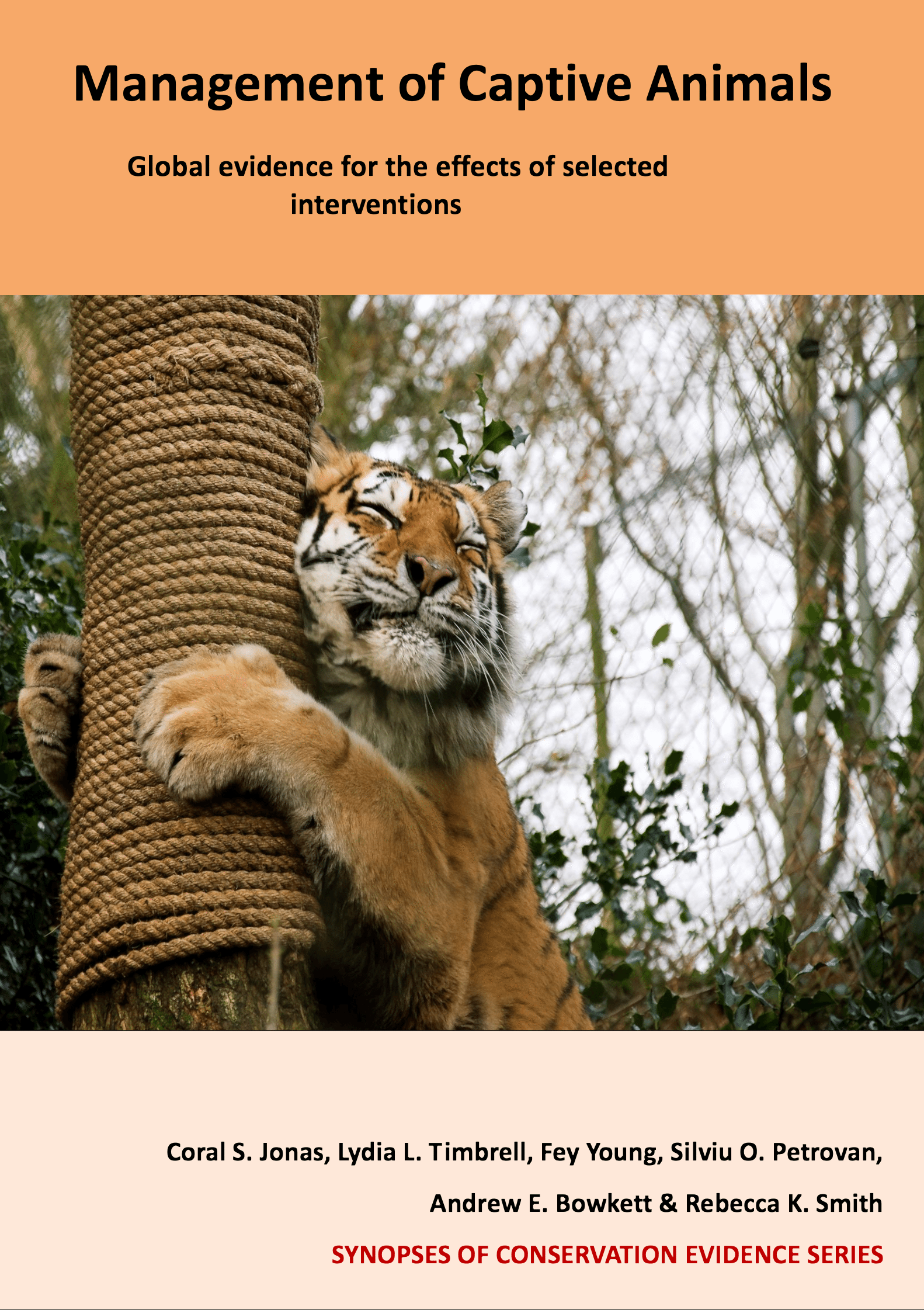Carnivores: Present food inside objects (e.g. Boomer balls)
Overall effectiveness category Likely to be beneficial
Number of studies: 4
View assessment score
Hide assessment score
How is the evidence assessed?
Effectiveness
60%Certainty
70%Harms
10%
Study locations
Supporting evidence from individual studies
A small before-and-after study in 1988 of a sloth bear Melursus ursinus in a zoo in the USA found that the first and second presentation of honey-filled logs decreased walking/pacing and explore/foraging behaviours compared to before enrichment. Both walking/pacing (first presentation: 10 min/day); second presentation: 71 min/day) and explore/foraging (first presentation: 13 min/day; second presentation: 35 min/day) behaviours decreased when presented with honey-filled logs (walk/pace: 124 min/; explore/forage: 60 min/day). Explore/forage behaviour was lower on the third presentation compared to before enrichment, however walk/pacing was not significantly lower. One sloth bear was presented with a honey-filled log after six days of baseline observations. The log was presented for five days and was refilled twice. The log was then removed for two days and re-presented for a further four days. Post test data was collected for five days and lastly the log was presented for five continuous days. A camera recorded six hours daily 09:30 h to 15:30 h and continuous focal sampling was performed.
Study and other actions testedA small before-and-after study in 1994 of spectacled bears Tremarctos ornatus in a zoo in Germany found that providing multiple feeding enrichments simultaneously, including logs filled with honey and raisins, increased the time bears spent foraging in the mornings compared to when the bears were fed conventionally, without enrichment. Using food as enrichment increased the time bears spent foraging in the morning (average number of scans: 24) compared to conventional feeding (10.6). There were no significant differences at other times of day. Feeding routine for three bears was switched weekly between an enriched routine, which included food holes, honey inside tree cavities and logs filled with raisins, and a conventional routine consisting of fruit, vegetables, bread and pellets fed twice daily. Behavioural observations were performed four days per week for three hours per day using instantaneous scan sampling, which started after they entered the exhibit in the morning for a total of 114 observational hours. Three 60 minute observation periods were carried out daily: between 08:30 h and 09:45 h, before noon, and early afternoon.
Study and other actions testedA before-and-after study in 2007 of sloth bears Melursus ursinus in a rescue centre in India found that providing honey-filled logs both intermittently or daily reduced the frequency of stereotypic behaviour and increased exploratory behaviour compared to no enrichment. The amount of time devoted to stereotypic behaviours was lower (intermittent: 22%; daily: 22%) and exploratory behaviours were higher (intermittent: 21%; daily: 17.5%) than without honey filled logs (stereotypic: 32.5%: explorative: 14.1%). Fourteen bears were fed three times daily which included porridge and mixed scattered fruit. Behaviour was recorded using instantaneous scan sampling with two minute intervals. Baseline data were collected for ten days before treatment. Enrichment regime included logs which could hold up to 200 g of honey. Two conditions were studied: 1) logs were introduced for five days in a row; 2) logs were introduced on days one, three and five. Behaviour was monitored between 15:00 h and 17:30 h on all five days of a treatment period, behaviour was monitored for another 6-10 days.
Study and other actions testedA replicated study in 2010 of grizzly bears Ursus arctos horribilis in a research facility in the USA, found that when presented with apples in boxes, they spent more time manipulating the object compared to an empty cardboard box but a similar time manipulating freely available apples. The bears spent more time manipulating a cardboard box filled with apples (524 seconds) and free apples (1060 seconds) compared to an empty cardboard box (105 seconds). Six bears were fed simultaneously over three days, consisting of three one hour trials. Each bear was presented with free apples, apples in cardboard box and a cardboard box. Behaviour was recorded using continuous focal sampling for one hour observation periods.
Study and other actions tested
Where has this evidence come from?
List of journals searched by synopsis
All the journals searched for all synopses
This Action forms part of the Action Synopsis:
Management of Captive Animals
Management of Captive Animals - Published 2018
Captive Animal Synopsis




















